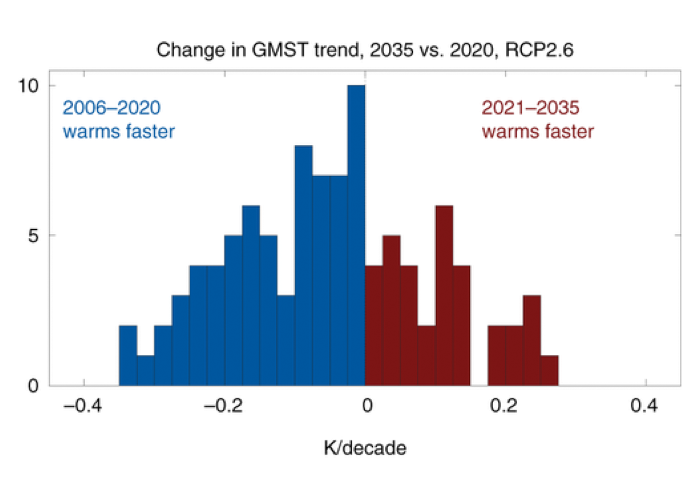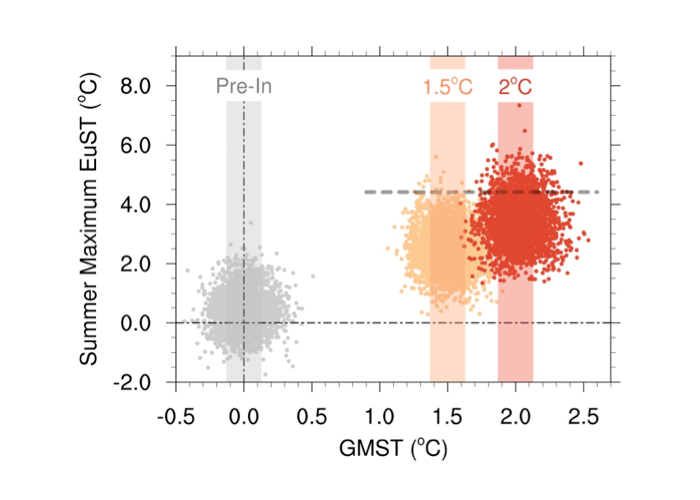The Max Planck Institute for Meteorology Grand Ensemble – an instrument for studying the internal variability of the climate system

Historical (blue)
RCP2.6 (yellow)
RCP4.5 (green)
RCP8.5 (purple)
1%CO2 (pink)
The Grand Ensemble also has a 2000 year preindustrial control simulation, run with 1850 conditions.
A multitude of model simulations was performed for this project with the MPI Earth system model (MPI-ESM). They slightly differ in their initial conditions but are subject to the same external forcings, i.e. increasing greenhouse gases, volcanic eruptions, land use and aerosols. For the historical climate from 1850 to 2005, for each of the three different future scenarios and for idealised climate change calculations one hundred model simulations were performed. In the process, the climate always reacts in the same way to the external forcings but differently to the internal variability. Therefore, a very large ensemble of model simulations is suited for studying the internal variability and external forcings as well as to separate them from one another. The understanding of changes in the climate system under the influence of global warming improves through this multitude of realizations, especially with respect to changes of extreme values. Furthermore, a large ensemble of simulations is suited to make a more robust evaluation against observations, which are also subject to internal variability.
The Max Planck Institute for Meteorology Grand Ensemble (MPI-GE) is the largest ensemble of a single state-of-the-art comprehensive climate model currently available. In contrast to comparable projects of other institutes, the MPI-GE provides a considerably larger number of realizations. It was also the first large ensemble with several different future scenarios. Large ensembles are the best instrument to precisely quantify the possible projections under different climate conditions (scenarios). This is not possible, for example, with the model simulations of the Coupled Model Intercomparison Projects (CMIP). Though their ensembles allow evaluating the combined effect of internal variability, external forcings and physical model uncertainty of individual models in climate projections, but the precise separation of internal variability from the external forcings cannot be achieved with a limited number of ensemble runs of a single model.
Three application examples
A study published this year (Marotzke, 2019) uses different future scenarios to show that even if CO2 emissions are reduced, there will not necessarily be a slowdown in global warming over the next 15 years (Fig. 1) as the internal variability masks the externally driven signal. This recognition of some irreducible uncertainty in possible developments in the near future is relevant for the political decision-making.

Another study examines the future evolution of Arctic sea ice under low warming scenarios (Niederdrenk and Notz, 2018). The authors find that depending on the observational dataset used to estimate the future evolution of sea ice, the Arctic Ocean will be ice-free for most summers once temperatures exceed a threshold between 1.7 °C and 2.2 °C. The main source of uncertainty for this threshold stems from observational uncertainty in both the estimate of the global warming and of the sea ice area. This uncertainty dominates over the uncertainty arising from internal variability. The authors are the first to combine observations of global-mean temperature and Arctic sea ice area with MPI-GE to estimate the future evolution of Arctic sea ice. They find that for Arctic sea ice, it really matters whether global warming is limited to 1.5 °C or 2.0 °C: Chances of a complete ice loss during summer are substantially increased for 2.0 °C global warming. The MPI-GE enables this robust comparison of future climate under different warming conditions.
In another publication, Suarez-Gutierrez et al. (2018) examine to what extent extreme European summer temperatures at 2°C of global warming could be avoided in a 1.5 °C warmer world. In other words, they examine to what extent extreme European summer temperatures could be controlled by limiting global warming to the global-mean temperature limits of the Paris Agreement. To evaluate the controllability of European summer temperatures with global-mean temperature limits, the MPI-GE is used. With it, the researchers try to robustly characterize the irreducible uncertainty that arises from chaotic internal variability.
The paper offers a new perspective, because it not only focuses on the differences between the average climates under 1.5°C and 2°C of global warming, but rather on evaluating the full spectrum of possible European summer temperatures that arises through internal variability under both climate targets. Using the MPI-GE the authors sample the full range of irreducible uncertainty, and find that only 10% of the most extreme summer temperatures at 2°C could be avoided by limiting global warming to 1.5°C. However, although only 10% of the most extreme temperatures could be avoided, these events would correspond to the most extreme and severe heat waves, the ones with the most critical consequences. The authors also find that, due to the strong effect of internal variability, only 40% of the summer months at 1.5°C would have temperatures that could be distinguishable from those at 2°C of global warming (Fig. 2).

Use of the MPI-GE
The MPI-GE simulations have been publicly available since early 2019 and are used by researchers around the world. The description of the simulations as well as an overview of four novel applications were published by Maher et al. (2019). These novel applications are only possible with a large ensemble and illustrate the power of MPI-GE.
The first application demonstrates the pathway dependence of temperature and precipitation responses under differing future scenarios, something that can currently only be addressed using the multiple future scenarios of MPI-GE. The MPI-GE allows the quantification between the climate responses in different scenarios and to compare them to the magnitude of the internal variability. The scientists found that the relation of temperature and precipitation is not consistent on all scenarios, and that there is a pathway dependence for the precipitation but not for the temperature. This dependence is likely due to the differing aerosol forcing between scenarios. We find that the differences between scenarios for the precipitation in certain regions (western Pacific Ocean, eastern South America and in parts of Africa and South Asia) are larger than the internal variability.
A second analysis investigates how changes in the highly variable atmospheric circulation will unfold in the future. So far, projected changes of the tropospheric jets and of the stratospheric polar vortex are highly uncertain. Thus, the polar vortex is possibly weakening already now due to anthropogenic warming. This weakening, however, might be masked by the internal variability of the climate system. Using MPI-GE, it is possible to estimate the historical and the future scenario development and identify circulation changes for the future with the help of time series of annual differences between the ensemble means and the pre-industrial ensemble means.
A third area of application is the investigation of the time dependence of variability in the Atlantic Meridional Overturning Circulation (AMOC). With projections of a decreasing AMOC strength under anthropogenic warming, the North American and European climates are expected to significantly alter. While a weakening of the AMOC is associated with stronger global warming, internal variability also plays an important role in driving the climate response. Maher et al. (2019) show that the future weakening of AMOC variability occurs in all scenarios in the first half of the 21st century, then followed by stabilization, which clearly demonstrates that the changes in projected AMOC variability have a high time dependence.
In their fourth analysis, Maher et al. (2019) use the example of trends in surface pressure to show how the 100-member ensemble can be used to estimate the ensemble size needed for a specific application. While MPI-GE can be applied to address this question, the answer will depend on both the question asked, how large an error is acceptable to the user, and likely the model used. When the ensemble size needed approaches the size of the ensemble itself, it can be difficult to determine whether the ensemble is large enough or the apparent error is only reduced because of resampling from a limited sample. Generally, it is recommended to use larger ensembles in order to reach robust estimates regarding model dependence of forced trends.
Internationally, MPI-M takes a leading role in the field of large ensemble modeling and actively supports the collaboration of different researchers. A special edition of the journal “Earth System Dynamics” is currently being prepared, collecting the publications on the subject of large ensemble modeling.
Building on the existing experiments, more simulations have been added to the MPI-GE over the last months. These further simulations permit answering new research questions by a higher temporal resolution of the output as well as other adaptations. This extension of MPI-GE results from a close cooperation with Universität Hamburg and the German meteorological service (DWD). In cooperation with Ludwig-Maximilian-Universität München, a seminar was organized in October 2019 aiming at developing new modeling approaches based on the large ensemble simulations.
Conclusion
Due to its large size and multiple scenarios, MPI-GE is a powerful tool for investigating uncertainties originating from internal variability and from unknown future pathways. Much can be learnt from using this ensemble alone and also in combination with observations and with other large-ensemble projects. MPI-GE simulations are now publicly available. Future studies that combine multiple large ensembles and, in particular, compare the magnitude of model uncertainty to internal variability, will be vital in determining the model uncertainties and further expanding the work with the individual model ensembles.
Cited literature
Marotzke, J. (2019) Quantifying the irreducible uncertainty in near-term climate projections, WIREs Clim Change, 10(1), e563–12, doi:10.1002/wcc.563.
Maher N., S. Milinski, L. Suarez-Gutierrez, M. Botzet, M. Dobrynin, L. Kornblueh, Y. Takano, J. Kröger, R. Ghosh, C. Hedemann, C. Li, H. Li, E. Manzini, D. Notz, D. Putrasahan, L. Boysen, M. Claussen, T. Ilyina, D. Olonscheck, T. Raddatz, B. Stevens, and J. Marotzke (2019) The Max Planck Institute Grand Ensemble: Enabling the Exploration of Climate System Variability, J. Adv. Model. Earth Syst., 28, 867–20, doi:10.1029/2019MS001639.
Niederdrenk, A. L., and D. Notz (2018) Arctic Sea Ice in a 1.5°C Warmer World, Geophys. Res. Lett., 45(4), 1963–1971, doi: 10.1002/2017GL076159.
Suarez-Gutierrez L., C. Li, W. A. Müller, and J. Marotzke (2018) Internal variability in European summer temperatures at 1.5°C and 2°C of global warming. Environ. Res. Lett. doi:10.1088/1748-9326/aaba58.
Contact
Dr. Nicola Maher
Max Planck Institute for Meteorology
Email: nicola.maher@mpimet.mpg.de
Dr. Sebastian Milinski
Max Planck Institute for Meteorology
Email: sebastian.milinski@mpimet.mpg.de
Dr. Laura Suarez-Guiterrez
Max Planck Institute for Meteorology
Email: laura.suarez@mpimet.mpg.de

